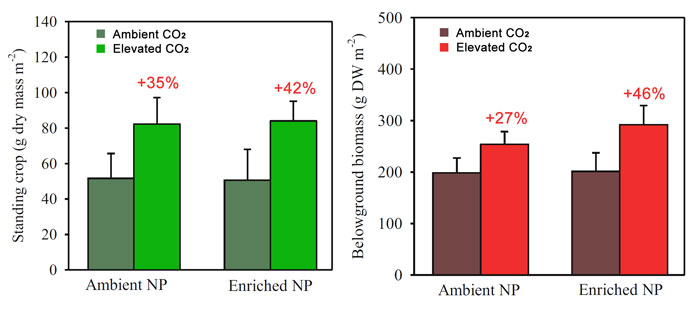| Tweet | Follow @co2science |
Paper Reviewed
Campbell, J.E. and Fourqurean, J.W. 2018. Does nutrient availability regulate seagrass response to elevated CO2? Ecosystems 21: 1269-1282.
Noting that "many seagrasses may benefit from forecasted increases in CO2(aq) concentrations because photosynthesis is limited by CO2(aq) availability at the pH of modern seawater," authors Campbell and Fourquerean (2018) investigated the long-term response of a seagrass community dominated by Thalassia testudinum to elevated CO2 and nutrient supply.
Their study was conducted in situ at a shallow seagrass bed (1 m depth) located in the Florida Keys, USA. Clear, open-top acrylic chambers were placed inside the seagrass bed and CO2 was injected into half of the chambers to maintain an approximate 0.3-unit reduction in seawater pH. The other half of the chambers were maintained at normal seawater pH. In addition, to further examine the impact of nutrient supply, half the chambers in each pH treatment received no fertilizer and half received a dose of nitrogen (N) and phosphorus (P) on a monthly basis. The CO2 and nutrient treatments were maintained for a period of one year.
The results of the analysis revealed that elevated CO2 had a positive impact on seagrass growth, increasing the standing crop by 35% and 42% and the belowground biomass by 27% and 46% under ambient and enriched nutrient application, respectively (see Figure 1 below). Growth parameters also tended to respond positively to nutrient application, but in a less-significant manner to that of CO2 and there were no additive effects of CO2 and nutrient supply. Consequently, the authors say that because nutrient availability "did not alter CO2 effects at our site, [the data suggest] that even relatively nutrient-poor plant communities may positively respond to elevated CO2 over sufficient timescales."
One other important finding to note was the authors' additional observation that there was "no long-term effect of elevated CO2 on seagrass nutrient content."
In commenting on their work, Campbell and Fourquerean write that "elevated CO2 modestly increased seagrass standing crop, providing evidence that carbon enrichment will likely prove beneficial to submerged plants beyond enhancements in photosynthetic output." Furthermore, they note that because these positive responses "were not influenced by NP addition," it suggests that these CO2-induced benefits will occur "even in relatively nutrient-poor systems."

Figure 1. Standing crop (left panel) and belowground biomass (right panel) response of a Florida seagrass community to CO2(aq) and nutrient enrichment. Adapted from Campbell and Fourqurean (2018).




